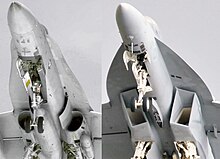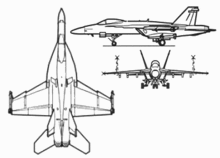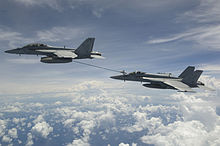Boeing F / A-18
| Boeing F / A-18E / F Super Hornet | |
|---|---|

|
|
| Type: | Multipurpose fighter |
| Design country: | |
| Manufacturer: | |
| First flight: |
November 29, 1995 |
| Commissioning: |
1999 |
| Production time: |
In series production since 1997 |
| Number of pieces: |
608 (April 2020) |
The Boeing F / A-18E / F Super Hornet is a twin - engine , carrier -based , multi -role fighter aircraft that is primarily used by the US Navy . This is a comprehensive new development of the F / A-18 Hornet , which is around 30% larger and considerably more powerful. The development of the Super Hornet was started by McDonnell Douglas . In 1997 Boeing took over McDonnell Douglas, developed the Super Hornet up to series production and continues to produce it today.
History and Development

In the 1980s led government under Ronald Reagan a massive increase in military spending, so that a plurality could be developed new and expensive weapons systems. The US Navy was looking for a replacement for its F-4 Phantom II and A-6 Intruder and possibly also for the F-14 Tomcat . The development of a fighter-bomber with extensive stealth properties was started. He should be made by General Dynamics and McDonnell Douglas and served as Delta - flying wing designed. The designation was A-12 Avenger II . However, due to significant cost overruns and various development problems, the program was discontinued in early 1991.
As alternatives, an improved F-14D Tomcat or a modernized F / A-18C / D Hornet came into focus. The new types were first called Super Tomcat and Hornet II . There was actually supposed to be a normal competition between the two prototypes, but the “Tailhook” meeting of naval pilots in September 1991 caused a serious political scandal (→ Tailhook scandal ), which forced many high-ranking officers to resign. The subsequent replacement in the upper echelons of the Navy resulted in a clear majority for the Hornet II , so that it was declared the successor to the failed A-12 Avenger II without any comparison with the Super Tomcat .
In June 1992, McDonnell Douglas then received the order to produce seven pre-series copies. The first of these aircraft left the factory in St. Louis on September 19, 1995; the first flight took place in November 1995. In November 1999 the first series aircraft were delivered to the Navy. In September 2001 the Super Hornet was officially put into service ( Initial Operating Capability ). On July 24, 2009, Boeing delivered the 400th Super Hornet to the Navy.
Against the background of the delayed introduction of the F-35C , the US Navy plans to procure 24 to 36 additional Super Hornets between 2016 and 2018 . Otherwise, the USN would be short of about 140 fighters between 2020 and 2025. At the same time, the older F / A-18C is to be modernized in order to increase the available flight hours from 6,000 to 10,000. The USN's Air Force Commander, Rear Adm. Mike Manazir, suggested on November 2, 2015 that the USN could be dependent on the services of the F / A-18E / F until 2040.
It is envisaged that the Blue Angels will switch from the F / A-18A and B Hornet versions to 9 Boeing F / A-18E and 2 F / A-18F Super Hornets between 2021 and 2022 . All jets have only been changed slightly for use in the squadron: in addition to the expansion of the M61 Vulcan automatic cannon to create space for the paraffin oil tank, the function of the control stick is improved in order to optimize control during overhead flight. The paraffin oil injected into the running engines is used to generate a trail of smoke behind the aircraft, which makes it easier for spectators to follow the flight paths and makes the position of an approaching aircraft more visible to the pilots. Each of the Blue Angels aircraft is basically combat-ready. After minor modifications and a new paint job, each jet could be used in combat within 72 hours.
Construction and technology
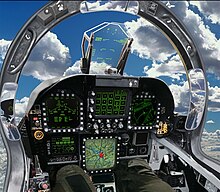
The airframe of the Super Hornet is much larger than that of the Hornet . The wings are 25% larger, the engines (two F414-GE-400 ) deliver 35% more thrust and the internal fuel capacity has been increased by 33%. The aim of these measures was above all to increase the range, which was the main criticism of the Hornet , as well as the landing weight, since the Hornet could not land on an aircraft carrier with full drop tanks or bomb load. This enabled the deployment radius to be increased by around 40% and up to 60% more payload to be brought back to the carrier (maximum 4,080 kg). Special distinguishing features of the Super Hornet are the diamond-shaped air inlets and the significantly larger strakes .
All modern weapons and external navy navigation / target lighting pods have also been integrated and two additional weapon stations have been added. Furthermore, the self-defense systems were brought up to date ( AN / ALQ-165 , AN / ALR-67 (V) 2 , AN / ALE-47 and AN / ALE-50 ) and a new IFF system of the type AN / APX -111 installed. Nevertheless, 90% of the maintenance-critical parts are identical to those of the Hornet . In the cockpit, the CRT-MFDs have been replaced by larger, colored LCDs . There is now a touchscreen under the HUD , the analog displays for the engines and the fuel system have been replaced by two monochrome LCD screens. In addition, the ejection seat was replaced by a new model ( SJU-5/6 ). A new energy system increases the available electrical power compared to the F / A-18C / D by 60%.
With the Super Hornet , emphasis was also placed on a lower radar signature . This can be seen most clearly in the new air inlets. The structure is similar to the concept used for the F-22 Raptor and reduces the radar cross-section through the diamond shape and the extensive shielding of the engine blades , which would otherwise have produced a significant radar echo. This also prevents the enemy from identifying the aircraft if their radar has a conventional NCTI operating mode that can recognize aircraft types based on the special echo patterns of their engines. More radar absorbing materials (RAM) were also used than the F / A-18C / D. The surface has generally been designed with more care in terms of the radar signature. Furthermore, some maintenance hatches are provided with a sawtooth pattern, which together with structure transitions, edges and external antennas arranged at the same angle leads to a further reduction in the radar echo.
Upgrades
Block II
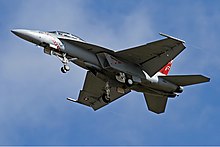
During this upgrade, the avionics in particular were comprehensively modernized. The AN / APG-73 radar is being replaced by the much more powerful AN / APG-79 . It is based on AESA technology, which, compared to conventional radars, has significantly better range, reliability, electronic protective measures and multi-target combat. It has a total of 1100 transmitters and has LPI properties. Compared to a target with a radar cross section (RCS) of one square meter, it achieves a range of around 125 km. Of the total of 552 Super Hornets planned , 415 are to be equipped with this radar, with Block I machines being retrofitted accordingly. The defensive EloKa capacities have also been expanded considerably. The improved (V) 3 version of the AN / ALR-67 radar warning device is now used, combined with the new EloGM system AN / ALQ-214 , in which the new AN / ALE-50 or -55 drag bait is integrated . Furthermore, the newly developed target acquisition and target illuminator container AN / ASQ-228 Advanced Targeting Forward-Looking Infrared (ATFLIR) can now also be used. For aerial reconnaissance is the Raytheon Shared Reconnaissance Pod (SHARP) - reconnaissance pod available, the image data obtained can display both directly in the cockpit or digitally store and send data by radio to a ground station. Modifications were also made in the cockpit area. The rear cockpit of the weapons system officer (WSO) has been redesigned and now contains a 20 × 25 cm screen for the tactical situation. In order to achieve better performance in close combat, the pilot and the WSO get the new JHMCS helmet. New processors have also been installed and many network connections are now made using optical fibers.
The first Block II machine was delivered on April 21, 2005 and by the beginning of 2007 this number had increased to eleven. In the future, a dedicated IRST infrared system is to be used to better capture aerial targets, with Lockheed Martin receiving a production order for 150 devices on July 2, 2007. The entire system is integrated into the top of a 440- gallon drop tank, reducing its capacity to 330 gallons (≈1250 liters). The system will be used as "Block II IRST" in the Block III machines.
General Electric introduced various further developments of the F414 engines over time. The version Enhanced Durability Engine (EDE), Enhanced Performance Engine (EPE) and Increased Performance Engine (IPE) are major modifications, whereby only the EPE variant has so far been developed for series production. This has been available for retrofitting since the beginning of 2009 and achieves a thrust of up to 118.36 kN (with post-combustion).
Block III
The upgrade to Block III was decided in 2017 and includes all aircraft with more than 6000 flight hours. The upgrade includes new conformal fuel tanks (CFT) under the wings and on the back of the fuselage for increased range. Also new is the TTNT data link ("Tactical Targeting Network Technology") for communication with EA-18G and Grumman E-2 . A broadband network is created between the machines in order to enable various sensors to be recorded and processed together. These are used, for example, to precisely collect target parameters for guided weapons.
Block III also integrates a new cockpit system, previously such a machine at Kuwait in 2019 and a test aircraft of the US Navy from the end of 2019. The upgrades are expected to be delivered in 2020 with maintenance work on the remaining aircraft. A single large 19-inch LCD display is now used for the instrument display, which the pilot can configure himself. This enables a better view of the displays and situation pictures. There is also a smaller HUD.
Improvements are being made to the radar signature. The airframe is designed for at least 10,000 flight hours through various structural reinforcements.
EA-18G growler
The EA-18G Growler is an EloKa variant of the two-seat F / A-18F Super Hornet , which replaces the EA-6B Prowler in the US Navy . The primary difference to the basic version is the adaptation of the EloKa systems AN / ALQ-99 and AN / ALQ-218 manufactured by Northrop Grumman . Series production of the EA-18G began in 2007, and since 2009 it has been in active service with the US Navy, which plans to purchase a total of 114 Growlers. The machines were first deployed over Libya as part of Operation Odyssey Dawn .
Technical specifications
| Parameter | Data |
|---|---|
| crew |
|
| Top speed | 1,915 km / h |
| length | 18.32 m |
| span |
|
| height | 4.88 m |
| Wing area | 46.45 m² |
| Wing loading | 298-644 kg / m² |
| Empty mass | 13,864 kg |
| normal takeoff mass | 21,320 kg |
| Max. Takeoff mass | 29,937 kg |
| Max. Fuel capacity |
|
| Top speed | > Mach 1.8 (at optimal height) |
| Service ceiling | 15,240 m |
| Max. Rate of climb | 229 m / s |
| Use radius |
|
| Range |
|
| endurance | 2 h 15 min 2 |
| Max. Gun load | 8,030 kg |
| Engines | two General Electric F414-GE-400 turbofans |
| Thrust |
|
| Thrust-to-weight ratio | 0.67-1.44 |
1 Hi-Lo-Lo-Hi profile with 4 × GBU-31 + 2 × AIM-9 + 2 × additional tanks, each with 1800 l
2 airspace protection; 280 km away from the carrier; 6 × AIM-120 + 3 additional tanks with 1800 l each
Armament / loading
As a multi -role combat aircraft, the F / A-18E / F Super Hornet has a wide range of compatible weapons, similar to the F-16. For this purpose, up to 8,030 kg payload can be carried at 11 weapon stations. The Super Hornet also has an internal M61A2 Vulcan cannon with 578 rounds of ammunition. The following table lists the various armament options. The numbering of the weapon stations can be read from left to right. Numbers 1/11 are stations on the wing tips, numbers 2/3/4/8/9/10 are under the wings and stations 5/6/7 are on the fuselage.
| weapon | 1 | 2 | 3 | 4th | 5 | 6th | 7th | 8th | 9 | 10 | 11 | annotation |
|---|---|---|---|---|---|---|---|---|---|---|---|---|
| Air-to-air guided missile | ||||||||||||
| AIM-9 Sidewinder | 1 | 1 | 2 | 2 | - | - | - | 2 | 2 | 1 | 1 | |
| AIM-7 Sparrow | - | 1 | 1 | 1 | 1 | - | 1 | 1 | 1 | 1 | - | |
| AIM-120 AMRAAM | - | 1 | 2 | 2 | 1 | - | 1 | 2 | 2 | 1 | - | |
| Air-to-surface guided missile | ||||||||||||
| AGM-65 Maverick | - | 1 | 1 | 1 | - | - | - | 1 | 1 | 1 | - | |
| AGM-84 Harpoon | - | - | 1 | 1 | - | - | - | 1 | 1 | - | - | |
| AGM-84H SLAM-ER | - | - | 1 | 1 | - | - | - | 1 | 1 | - | - | |
| AGM-88 HARM | - | 1 | 1 | 1 | - | - | - | 1 | 1 | 1 | - | |
| AGM-154 JSOW | - | - | 1 | 1 | - | - | - | 1 | 1 | - | - | |
| AGM-158 JASSM | - | - | 1 | 1 | - | - | - | 1 | 1 | - | - | |
| AGM-158C LRASM | - | - | 1 | 1 | - | - | - | 1 | 1 | - | - | Integration planned for 2019. |
| Air-to-ground free-fall ammunition | ||||||||||||
| B61 | - | - | 1 | 1 | - | - | - | 1 | 1 | - | - | Integration of the B61 Mod. 12 planned. |
| GBU-10/12/16 | - | 1 | 2 | 2 | - | 1 | - | 2 | 2 | 1 | - | |
| GBU-24 | - | - | 1 | 1 | - | - | - | 1 | 1 | - | - | |
| GBU-31/32/38 JDAM | - | - | 1 | 1 | - | - | - | 1 | 1 | - | - | |
| Mark 82 bomb / 83 | - | 1 | 2 | 2 | - | 1 | - | 2 | 2 | 1 | - | |
| Additional container | ||||||||||||
| Dump tank | - | - | 1 | 1 | - | 1 | - | 1 | 1 | - | - | |
| Air refueling tanks | - | - | - | - | - | 1 | - | - | - | - | - | |
EloKa systems
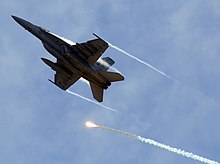
Users
-
 Australia
Australia
- Royal Australian Air Force : 24 F / A-18F
-
 Kuwait
Kuwait
- Kuwaiti Air Force : 22 F / A-18E and 6 F / A-18F (ordered in 2018 with option for 12 aircraft)
-
 United States
United States
- United States Navy : 608 Block II (322 F / A-18E and 286 F / A-18F)
Web links
- Fact sheet of the US Navy (English)
- Boeing.com (English)
- Globalsecurity.org (English)
Individual evidence
- ^ Naval Aviation News. March / April 1999, p. 30 (English)
- ↑ Navy takes delivery of final Block II Super Hornet, looks ahead to Block III. In: navy.mil. April 24, 2020, accessed on July 27, 2020 .
- ↑ Boeing - Boeing Delivers 400th F / A-18E / F Super Hornet to US Navy , July 24, 2009. Accessed July 25, 2009
- ↑ US Navy acquires additional F / A-18s . In: European Security & Technology 1/2016. P. 68.
- ↑ Les Blue Angels on Super Hornet!
- ↑ a b c Vectorsite.net - Boeing F / A-18E / F Super Hornet , accessed September 7, 2008
- ↑ Jane's All The World's Aircraft 2004-2005, p. 585.
- ^ Ian Moir and Allan G. Seabridge: Military Avionics Systems . John Wiley & Sons Ltd., 2006, ISBN 0-470-01632-9 . , Page 253
- ↑ Is the JSF really good enough? - analyzing the ASPI paper ( Memento from October 25, 2011 in the Internet Archive ) by Dr. Carlo Kopp and Peter Goon, page 3
- ↑ Description of the AN / ASQ-228 ATFLIR (PDF, 144 kB, English) ( page no longer available , search in web archives ) Info: The link was automatically marked as defective. Please check the link according to the instructions and then remove this notice.
- ↑ MD Duncan, MR Kruer, DC Linne von Berg and JN Lee: Technology Demonstration of SHARP, the Navy's Next-Generation Tactical Reconnaissance System on the website of the US Naval Research Laboratory; viewed on February 4, 2009 ( memento from January 18, 2008 in the Internet Archive )
- ↑ Lockheed Martin's Tactical Input Segment Demonstrates Full Interoperability With F / A-18 SHARP Sensor on the Lockheed Martin website ( page no longer available , search in web archives ) Info: The link was automatically marked as defective. Please check the link according to the instructions and then remove this notice.
- ↑ Defense Industry Daily - JHMCS: Fighter Pilot "Look & Shoot" Helmets' Upgrade, Ups & Downs , accessed June 8, 2010
- ↑ Boeing F / A-18E / F Super Hornet Block III. Accessed January 4, 2020 (German).
- ↑ Flight Global Journal - Boeing's Super Hornet seeks export sale to launch 20% thrust upgrade , May 12, 2009
- ↑ Boeing F / A-18E / F Super Hornet Block III. Accessed January 4, 2020 (German).
- ↑ Dave Majumdar: Why Boeing's Block III F / A-18E / F Super Hornet Is About to Become a Reality. June 22, 2017, accessed January 4, 2020 .
- ^ Large and In charge. Boeing, February 14, 2019, accessed December 9, 2019 .
- ↑ Boeing F / A-18E / F Super Hornet Block III. Retrieved January 4, 2020 (en-EN).
- ↑ Boeing awarded contract to deliver 28 Super Hornets to Kuwait. FlightGlobal, April 2, 2018, accessed April 5, 2018 .
- ↑ Garrett Reim: Boeing delivers last Block II F / A-18E / F Super Hornet to the US Navy. In: flightglobal.com. April 24, 2020, accessed on April 27, 2020 .

